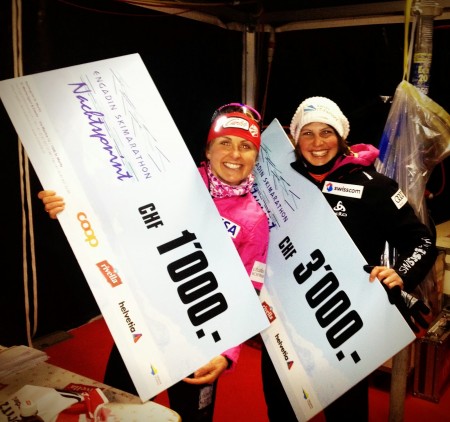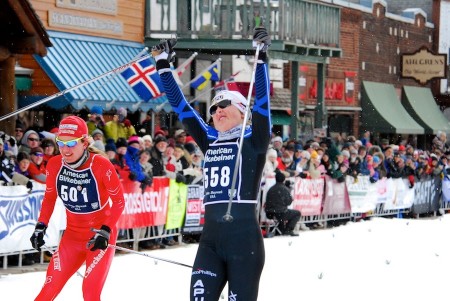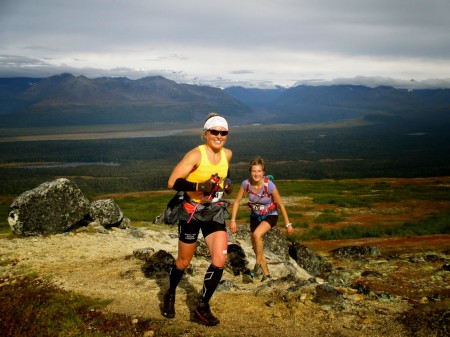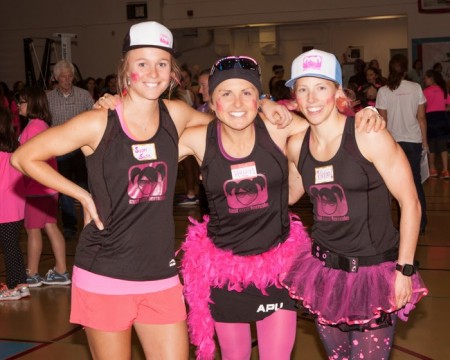October 20th, 2014 - first day on snow in AK. It was marginal at best but I was striding and gliding. The key was skiing in places that hadn't been touched yet because as you can see, I was hitting the grass! So, I was ski/snow "mining" making sure to get the most out of the terrain. It wasn't much but more white stuff is in the forecast tomorrow so time will tell.
Also, I'm really excited to announce a new partnership with the American Birkie for the upcoming winter!!!! I could write about it but Alex Kochen (formally Matthews) wrote a really nice piece for Faster Skier that was published this morning. Here is the link to read it on Fasterskier. Or, for those of you who don't like opening new windows (!) I've pasted it below for your reading enjoyment.
Crossing my fingers for snow for everyone!
New Birkie Ambassador, Brooks Going for FIS Marathon Cup Overall Podium (Updated)

Holly Brooks during the Kesugi Ridge Traverse Trail Run in Denali State Park on Sept. 6. She placed second in the 28-mile race. (Photo: Holly Brooks/HollySkis.Blogspot.com)
All spring, summer and fall, Holly Brooks has been training. For what? She wasn’t 100-percent sure until recently.
Regardless of whether she started the coming winter in the U.S. or abroad, former U.S. Ski Team member had been working on her strengths: distance and endurance. Of course, Brooks, 32, knew she’d have to add in some speed here and there to learn how to respond to the pivotal moment in any race: the break.
She’d done some traditional training with her team, Alaska Pacific University (APU) in Anchorage, but for the first time since she made the U.S. Ski Team (USST) in 2012, she didn’t join its annual October camp in Park City, Utah. Instead, she was enjoying more flexibility in her life, like mountain biking in the Yukon with her husband Rob Whitney, while balancing her workouts with schoolwork as a counseling psychology grad student (with an emphasis on sport psychology) at APU.

Holly Brooks (l) and Switzerland’s Bettina Gruber after placing third and first, respectively, in the St. Moritz night sprints before last year’s Engadin Marathon in Switzerland, where Brooks placed fourth after a late crash. (Photo:Hollyskis.blogspot.com)
In late September, Brooks announced her race intentions for the 2014/2015 season on her blog, Taking on the FIS World Loppet Marathon Series – ALONE.
“Typing the title of this blog solicits two very different responses from me,” she began. “The first excitement, the second terror.”
In a follow-up email, Brooks explained she named her winter: “Holly’s Distance Racing Project — Exploring the world and its people one ski marathon at a time.”
That made tackling the International Ski Federation (FIS) Marathon Cup series, with nine scored races between December and March, and her goal of landing in the overall top three, a little less intimidating.
To do so, she’ll be the American Birkebeiner’s first elite ambassador, which should help out with race entries and accommodations at the seven FIS Marathon Cup/Worldloppet races she plans to do. The Birkebeiner, also known as the Birkie, is the largest ski marathon in North America and one of 20 international Worldloppets.
“My goal is to increase awareness of ski marathons — to speak about the Birkie during my travels abroad as well as bring FIS Marathon stories back to North America,” she explained in an email.
“There are definitely a good handful of Americans that had experience with Worldloppets, but I don’t feel like anyone committed fully to the whole series and was real vocal,” she explained on the phone from Anchorage. “One of my goals is to go over and write about it and blog about it and make it more accessible to North Americans and make it more tangible in people’s minds.”
Announced Monday, Brooks became the Birkie’s first sponsored elite-athlete representative. In an email, American Birkebeiner Ski Foundation (ABSF) Executive Director Ben Popp wrote the foundation’s mission was to support the entire sport, and had previously done so in funding citizens races, youth and adult programs, and Wisconsin High School Nordic Ski Championships. Now, it was eager to sponsor Brooks and another elite ambassador Anne Hart, who grew up in Stillwater, Minn., skis for the Stratton Mountain School T2 Team and writes training tips on the Birkie website.

Holly Brooks winning the 2012 American Birkebeiner, four-tenths of a second ahead of Caitlin Gregg (l), for her first Birkie title. (Photo: Darlene Prois/ABSF)
“I’m excited to support [them] and help them be great role models for our next generation of skiers,” Popp wrote. “Additionally, having Holly chase the [FIS Marathon Cup] and skiing the Worldloppets will create a great amount of stories/visibility. … There are some really cool races around the world that many have no idea about. When [Birkie founder] Tony Wise created the Worldloppet, it was to create a medium ‘to travel the world through skiing.’ ”
While certain details of the partnership and its perks for Brooks weren’t immediately clear, she explained her goal is to increase interest and participation in the American Birkie, as well as promote the ABSF’s healthy lifestyle initiative during presentations in different countries.
“Sometimes motivation can be low, but when you commit to a race or an event, the incentive is real,” she said in a press release.
2014/2015 FIS Marathon Cup:
- Dec. 12: La Sgambeda 42 k (Italy)
- Jan. 18: Dolomitenlauf 60 k (Austria)
- Jan. 25: Marcialonga 70 k (Italy)
- Feb. 7: La Transjurassienne 56 k (France)
- Feb. 15: Tartu Marathon 63 k (Estonia)*
- Feb. 21: American Birkebeiner 50 k (Wisconsin)
- Feb. 28: Bieg Piastow 50 k (Poland)
- March 3: Engadin Skimarathon 42 k (Switzerland)
- April 4: UgraSki marathon 50 k (Russia)*
*
*Brooks does not plan to race
- Dec. 12: La Sgambeda 42 k (Italy)
- Jan. 18: Dolomitenlauf 60 k (Austria)
- Jan. 25: Marcialonga 70 k (Italy)
- Feb. 7: La Transjurassienne 56 k (France)
- Feb. 15: Tartu Marathon 63 k (Estonia)*
- Feb. 21: American Birkebeiner 50 k (Wisconsin)
- Feb. 28: Bieg Piastow 50 k (Poland)
- March 3: Engadin Skimarathon 42 k (Switzerland)
- April 4: UgraSki marathon 50 k (Russia)*
*
*Brooks does not plan to race
The Birkie on Feb. 21 is on her list of races this season, after the 56-kilometer La Transjurassienne in France (Feb. 7) and the 50 k Bieg Piastów in Poland (March 1).
That means FIS World Championships from Feb. 18 to March 1 are out for Brooks, who’s competed in the last two (in 2011 in Oslo, Norway, and 2013 in Val di Fiemme, Italy). She also represented the U.S. last winter at the 2014 Olympics in Sochi, Russia, as well as the 2010 Vancouver Olympics.
“I think World Championships in Falun [Sweden] are going to be amazing and I’m actually part Swedish, too, so that’s going to be a bummer,” she said. “But at the same time, I’ve been to two World Championships, including Holmenkollen and I’m not sure Falun is going to be able to top Holmenkollen to be honest…”
“I’m ready for new challenges,” she continued. “When it comes down to it, I’m a competitor and I want to be in races where I’m in contention for a podium … especially after having a difficult season last year …. I miss going for the win, I miss fighting for the podium and when you’re on full-time World Cup, you’re not really winning anything.”
She laughed.
At the same time, jumping into the unknown without any teammates, coaches or wax techs to fall back on made her somewhat anxious. That, and she didn’t have her season entirely mapped out in terms of how she’d pay for it — with flights from Alaska to Italy (for the La Sgambeda on Dec. 12), back home, then to Austria, Italy, France, then Wisconsin (for the Birkie). After that, it’s back to Europe to Poland, Switzerland (Engadin Skimarathon on March 8), and Norway (for potentially the Holmenkollen 30 k on March 15, if the U.S. Ski Team grants her a World Cup start, and the Norwegian Birkebeinerrennet 54 k classic on March 21). Finally, she plans to finish the season at SuperTour Spring Series from March 20-26 in Sun Valley, Idaho.

Holly Brooks around mile 12 of the 28-mile Kesugi Ridge Traverse Trail Runin Denali State Park on Sept. 6. (Photo: HollySkis.Blogspot.com)
In all, the traveling will amount to about one more trip to Europe than she’s used to (with an average plane ticket costing about $2,200), but on the bright side, she’ll spend Thanksgiving at home — possibly in Hope, where she and Whitney recently built a cabin with the help of their family.
“I’m actually going to have my first holidays at home for the first time since I can remember,” Brooks said. “And not just at home, in the states and at home.”
The unique marathon schedule requires her to start her season in early December in Italy, then fly home before her next race more than a month later. Considering her goal of a top three in the circuit and her decision to skip two of the nine scored races (the Tartu Marathon in Estonia and Ugra in Russia), she didn’t want to start the season having missed the first race.
It would be tough enough to achieve an overall podium at the end of the season; she didn’t need that initial mental hurdle of having to play catchup.
If all goes well, Brooks could make the Worldloppet’s selective red group with top results early on — as soon as after the first race. Much like on the World Cup, the red group comes with start rights and some support like room and board, although she’s not entirely sure how much, possibly two to three days of accommodation per race weekend.
“I’m not super familiar with all the rules because it’s such a new scene for me,” she said.
But with consistently competitive results, and the fringe benefits as an official Birkie ambassador, she hoped it would lighten the load and looming logistics of her season.
In addition to where she’ll stay during races, Brooks was unsure where she’d spend the weeks before and after each race in Europe, and who would help her find housing. But that’s where her connections from several years of international travel and pro racing could come into play; she’s established relationships she’s confident will help her in the months to come.
“I hope that word will get around that I’m … out there and I have this goal,” she said with a laugh. “I’m putting a lot of faith in strangers to help with logistics and the financial aspect.”
Compared to the World Cup, which costs $140 dollars per athlete per day based on the FIS fixed rate, there is no flat rate for the marathon circuit.
“Some of the countries are more expensive, some of them are a little bit cheaper,” she said. “It is really unclear how much this will cost. Part of me wants to have the whole season planned out in advance and know exactly where I’m staying and who’s going to be waxing my skis for every race, but I’ve come to the realization that I can’t take care of all those logistics ahead of time.
“One of the most intimidating parts of this goal is, not only do I have the regular fundraising to figure out, but I have all the logistics. I’m on my own,” she said. “[U.S. Ski Team Head Coach] Chris Grover is so organized and so good with logistics … and the coaches are always looking out for you and figuring out how you’re going to get to your next meal and how you’re going to get to the airport, and now that’s all on me.”
“While I’m dreading it, I’m excited for it.” — Holly Brooks, on her decision to go for an overall podium in the FIS Marathon Cup
When it comes to waxing her racing fleet (downsized from her 30 pairs of World Cup skis because she simply can’t carry that many alone), Brooks said she’ll rely on her sponsors, like Swix, and industry partners at certain races, like Salomon in France, and possibly the Birkie for individual attention (i.e., a personal tech).
“It’s scary because I know how hard I train and also how much money I’m spending,” she said. “To have skis that aren’t competitive could blow the whole thing, but that’s ski racing. I just have to do the best I can…”
Payouts for the marathons range, but the overall Marathon Cup winners receive a small crystal globe and about $7,500 dollars — thatsame amount each male and female Birkie winner gets. Second place earns $4,500 and third place gets $3,000.
“That goes to show I’m not doing it for the money,” Brooks said. “Winning is hard. I don’t know the exact level of competition, but I know what happened last year: [Finland’s] Riitta-Liisa Roponen won the overall and she won I think every Worldloppet race she entered.
“You could stand to do all right financially if you have all your expenses covered and you get to pocket your earnings,” she added. “I’m hoping to at least break even and not go into the red, but we’ll see. I have a couple irons in the fire and I’m hoping I [can] get people excited about the challenge that’s behind it.”
So far, her sponsors’ reactions have been favorable, although she said nothing was final yet.
Without teammates, Brooks could be looking for roommates to share the high cost of living in Europe. She entertained the idea of rooming with Roponen, “but I don’t know, I think she might think of me as a little more of a competitor than a teammate,” she laughed.
She considered racing for a professional European marathon team and had an offer from one, but Brooks declined the spot. “They wanted me to come over to Europe every month in the summer and fall, which is completely unrealistic when you think about it,” she said. “That wasn’t what I was looking for.”
Come February and March, she figured there might be a good possibility other Americans — those who don’t end up making World Championships — joining her at marathons like the Engadin and Birkebeinerrennet. But time will tell, and she was prepared to do it on her own.

Holly Brooks (c) with APU teammates and former U.S. Ski Team teammates Sadie Bjornsen (l) and Kikkan Randall at a recent Fast and Female event in Anchorage. (Photo: Hollyskis.blogspot.com)
“That’s one of the biggest differences going from being on a really strong team that is the U.S. women’s team to being a little bit more of a lone wolf,” Brooks said. “But I think that’ll force me out of my comfort zone … While I’m dreading it, I’m excited for it.”
Her decision to commit to the Worldloppet/Marathon Cup was a gradual one, starting with the idea that she might go to the SuperTour opener in West Yellowstone, then U.S. nationals, and potentially qualify for some World Cups.
“I kind of got sick of the maybe in my life,” she recalled. “Instead of just training and having no idea where I was going to be racing … I’m really excited to commit to this and solidify it. It’s pretty much all races that I haven’t been to before.”
In the meantime, she’s been taking classes three times a week, amounting to about nine to 10 hours of in-class time per week — not including the time she spends studying at home. On top of that, she typically trains 20-plus hours a week (and has another 10-15 hours of physical therapy) and stays involved with the community through events and presentations in her spare time.
“I’ve had to be really diligent with my time and be more focused and organized,” she said.
In early October, Brooks said she was thankful she didn’t have to rollerski first thing on a 19-degree Fahrenheit morning. She got on the Ski Erg instead.
Earlier this fall, she did an “all uphill” rollerski-running workout at Hatcher’s Pass with friend and videographer Max Romey, who filmed her with a drone.
“It would hover right over my head, then he would lift it up and do these wide-sweeping panoramic shots,” she explained. “It’s really, really cool.”
Romey published the video Oct. 12.
Best of all: “He sent me the whole hour-and-a-half unedited version that I could use for technique,” she said.
***
Update: Early Monday, Brooks explained a recent development and possible race addition to her upcoming winter schedule. In an email, she wrote that the rules state FIS Marathon Cup/Worldloppet racers cannot collect their overall prize money unless they are present for the final race — the UgraSki marathon in Russia one month after the Engadin, which Brooks initially planned to be her final scored race. She had intended to skip the Ugra as well as the Tartu Marathon in Estonia.
“There is currently no information about the Russian race available – at least the link from the FIS World Loppet site goes no where…,” Brooks wrote. “This is a huge bummer for many obvious reasons. I’m waiting to hear clarification on this rule as well as some details on the race.”
Filed Under: General, Interviews, Marathons, News, Racing · Tagged: 2014/2015 FIS Marathon Cup, 2014/2015 Worldloppet, ABSF,American Birkebeiner, ben popp, Birkie, FIS Marathon Cup, Holly Brooks, Worldloppet
Alex Kochon (formerly Matthews) is the managing editor at FasterSkier and to most people's surprise, not a guy. When she's not writing, you can find her outdoors in upstate New York or doing the gym thing as a certified personal trainer. Follow her on Twitter @active_alex.
